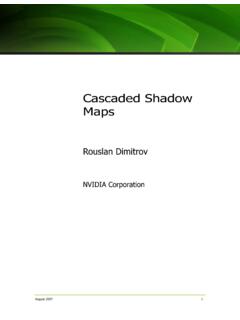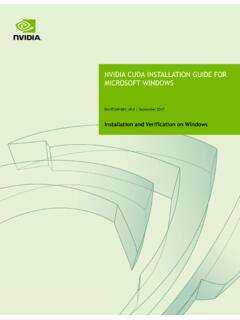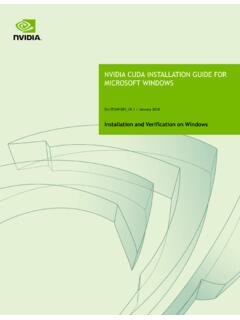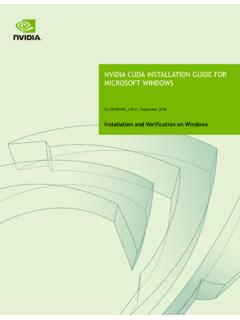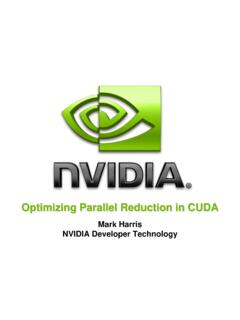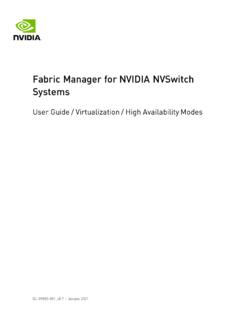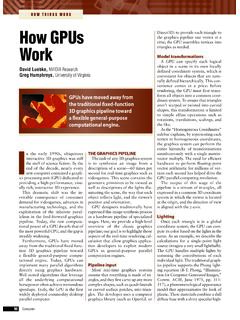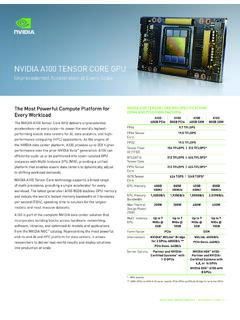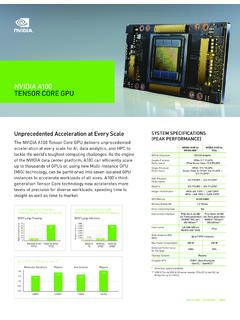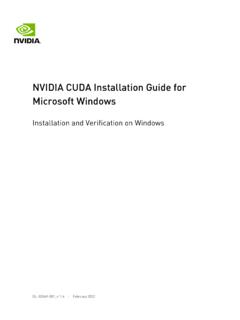Transcription of nvidia-smi.txt Page 1
1 Page 1nvidia-smi(1) nvidia nvidia -smi(1)NAME nvidia -smi - nvidia System Management Interface programSYNOPSIS nvidia -smi [OPTION1 [ARG1]] [OPTION2 [ARG2]] ..DESCRIPTION nvidia -smi (also NVSMI) provides monitoring and management capabilities for each of nvidia 's Tesla, Quadro, GRID and GeForce devices from Fermi and higher architecture families. GeForce Titan series devices are sup- ported for most functions with very limited information provided for the remainder of the Geforce brand. NVSMI is a cross platform tool that supports all standard nvidia driver-supported Linux distros, as well as 64bit versions of Windows starting with Windows Server 2008 R2.
2 Metrics can be consumed directly by users via stdout, or provided by file via CSV and XML formats for scripting purposes. Note that much of the functionality of NVSMI is provided by the under- lying NVML C-based library. See the nvidia developer website link below for more information about NVML. NVML-based python bindings are also available. The output of NVSMI is not guaranteed to be backwards compatible. How- ever, both NVML and the Python bindings are backwards compatible, and should be the first choice when writing any tools that must be main- tained across nvidia driver releases. NVML SDK: Python bindings: GENERAL OPTIONS -h, --help Print usage information and exit.
3 SUMMARY OPTIONS -L, --list- gpus List each of the nvidia gpus in the system, along with their UUIDs. QUERY OPTIONS -q, --query Display GPU or Unit info. Displayed info includes all data listed in the (GPU ATTRIBUTES) or (UNIT ATTRIBUTES) sections of this document. Some devices and/or environments don't support all possible informa- tion. Any unsupported data is indicated by a "N/A" in the output. By default information for all available gpus or Units is displayed. Use the -i option to restrict the output to a single GPU or Unit. [plus optional] -u, Page 2 Display Unit data instead of GPU data.
4 Unit data is only available for nvidia S-class Tesla enclosures. -i, --id=ID Display data for a single specified GPU or Unit. The specified id may be the GPU/Unit's 0-based index in the natural enumeration returned by the driver, the GPU's board serial number, the GPU's UUID, or the GPU's PCI bus ID (as domain: in hex). It is recommended that users desiring consistency use either UUID or PCI bus ID, since device enumeration ordering is not guaranteed to be consistent between reboots and board serial number might be shared between multiple gpus on the same board. -f FILE, --filename=FILE Redirect query output to the specified file in place of the default stdout.
5 The specified file will be overwritten. -x, --xml-format Produce XML output in place of the default human-readable format. Both GPU and Unit query outputs conform to corresponding DTDs. These are available via the --dtd flag. --dtd Use with -x. Embed the DTD in the XML output. --debug=FILE Produces an encrypted debug log for use in submission of bugs back to nvidia . -d TYPE, --display=TYPE Display only selected information: MEMORY, UTILIZATION, ECC, TEMPERA- TURE, POWER, CLOCK, COMPUTE, PIDS, PERFORMANCE, SUPPORTED_CLOCKS, PAGE_RETIREMENT, ACCOUNTING Flags can be combined with comma "MEMORY,ECC". Sampling data with max, min and avg is also returned for POWER, UTILIZATION and CLOCK display types.
6 Doesn't work with -u/--unit or -x/--xml-format flags. -l SEC, --loop=SEC Continuously report query data at the specified interval, rather than the default of just once. The application will sleep in-between queries. Note that on Linux ECC error or XID error events will print out during the sleep period if the -x flag was not specified. Pressing Ctrl+C at any time will abort the loop, which will otherwise run indef- initely. If no argument is specified for the -l form a default inter- val of 5 seconds is used. SELECTIVE QUERY OPTIONS Allows the caller to pass an explicit list of properties to query. [one of] --query-gpu= Information about GPU.
7 Pass comma separated list of properties you want to query. --query-gpu= ,persistence_mode. Call --help-query-gpu for more Page 3 --query-supported-clocks= List of supported clocks. Call --help-query-supported-clocks for more info. --query-compute-apps= List of currently active compute processes. Call --help-query-com- pute-apps for more info. --query-accounted-apps= List of accounted compute processes. Call --help-query-accounted-apps for more info. --query-retired- pages = List of GPU device memory pages that have been retired. Call --help-query-retired- pages for more info.
8 [mandatory] --format= Comma separated list of format options: csv - comma separated values (MANDATORY) noheader - skip first line with column headers nounits - don t print units for numerical values [plus any of] -i, --id=ID Display data for a single specified GPU. The specified id may be the GPU's 0-based index in the natural enumeration returned by the driver, the GPU's board serial number, the GPU's UUID, or the GPU's PCI bus ID (as domain: in hex). It is recommended that users desiring consistency use either UUID or PCI bus ID, since device enu- meration ordering is not guaranteed to be consistent between reboots and board serial number might be shared between multiple gpus on the same board.
9 -f FILE, --filename=FILE Redirect query output to the specified file in place of the default stdout. The specified file will be overwritten. -l SEC, --loop=SEC Continuously report query data at the specified interval, rather than the default of just once. The application will sleep in-between queries. Note that on Linux ECC error or XID error events will print out during the sleep period if the -x flag was not specified. Pressing Ctrl+C at any time will abort the loop, which will otherwise run indef- initely. If no argument is specified for the -l form a default inter- val of 5 seconds is used. -lms ms, --loop-ms=ms Same as -l,--loop but in milliseconds.
10 DEVICE MODIFICATION OPTIONS [any one of] -pm, --persistence-mode= Page 4 Set the persistence mode for the target gpus . See the (GPU ATTRIBUTES) section for a description of persistence mode. Requires root. Will impact all gpus unless a single GPU is specified using the -i argument. The effect of this operation is immediate. However, it does not per- sist across reboots. After each reboot persistence mode will default to "Disabled". Available on Linux only. -e, --ecc-config=CONFIG Set the ECC mode for the target gpus . See the (GPU ATTRIBUTES) section for a description of ECC mode.



